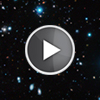CXC Home | Search | Help | Image Use Policy | Latest Images | Privacy | Accessibility | Glossary | Q&A
Tour of CL J1001
Quicktime MPEG
Galaxy clusters are incredibly important objects in the Universe since they are the largest objects in the Universe held together by gravity. Many galaxy clusters contain hundreds or even thousands of galaxies, enormous amounts of hot gas, and giant reservoirs of dark matter. For as much as they already know about galaxy clusters, astronomers are still seeking to learn more. This includes learning about how galaxy clusters first formed in the early Universe.
A new discovery by a team of researchers may represent an important step in that direction. Using NASA's Chandra X-ray Observatory and several other telescopes on the ground and in space, researchers recently found a galaxy cluster that is about 11.1 billion light years from Earth. In addition to its remarkable distance, this cluster, known as CL J1001+0220, also displays some intriguing qualities. For example, astronomers find that the core of this cluster is ablaze with star formation. This is quite different from other galaxy clusters observed by astronomers, where star formation rates are very low. It may be that this galaxy cluster represents a brief, but important, stage of the evolution where a cluster transitions from a still-forming cluster into a mature one. Astronomers hope that they will learn a lot about the formation of clusters and the galaxies they contain by studying this object.
[Runtime: 02:19]
Quicktime MPEG
Galaxy clusters are incredibly important objects in the Universe since they are the largest objects in the Universe held together by gravity. Many galaxy clusters contain hundreds or even thousands of galaxies, enormous amounts of hot gas, and giant reservoirs of dark matter. For as much as they already know about galaxy clusters, astronomers are still seeking to learn more. This includes learning about how galaxy clusters first formed in the early Universe.
A new discovery by a team of researchers may represent an important step in that direction. Using NASA's Chandra X-ray Observatory and several other telescopes on the ground and in space, researchers recently found a galaxy cluster that is about 11.1 billion light years from Earth. In addition to its remarkable distance, this cluster, known as CL J1001+0220, also displays some intriguing qualities. For example, astronomers find that the core of this cluster is ablaze with star formation. This is quite different from other galaxy clusters observed by astronomers, where star formation rates are very low. It may be that this galaxy cluster represents a brief, but important, stage of the evolution where a cluster transitions from a still-forming cluster into a mature one. Astronomers hope that they will learn a lot about the formation of clusters and the galaxies they contain by studying this object.
[Runtime: 02:19]
(Credit: NASA/CXC/A. Hobart)
Return to CL J1001 (August 30, 2016)



